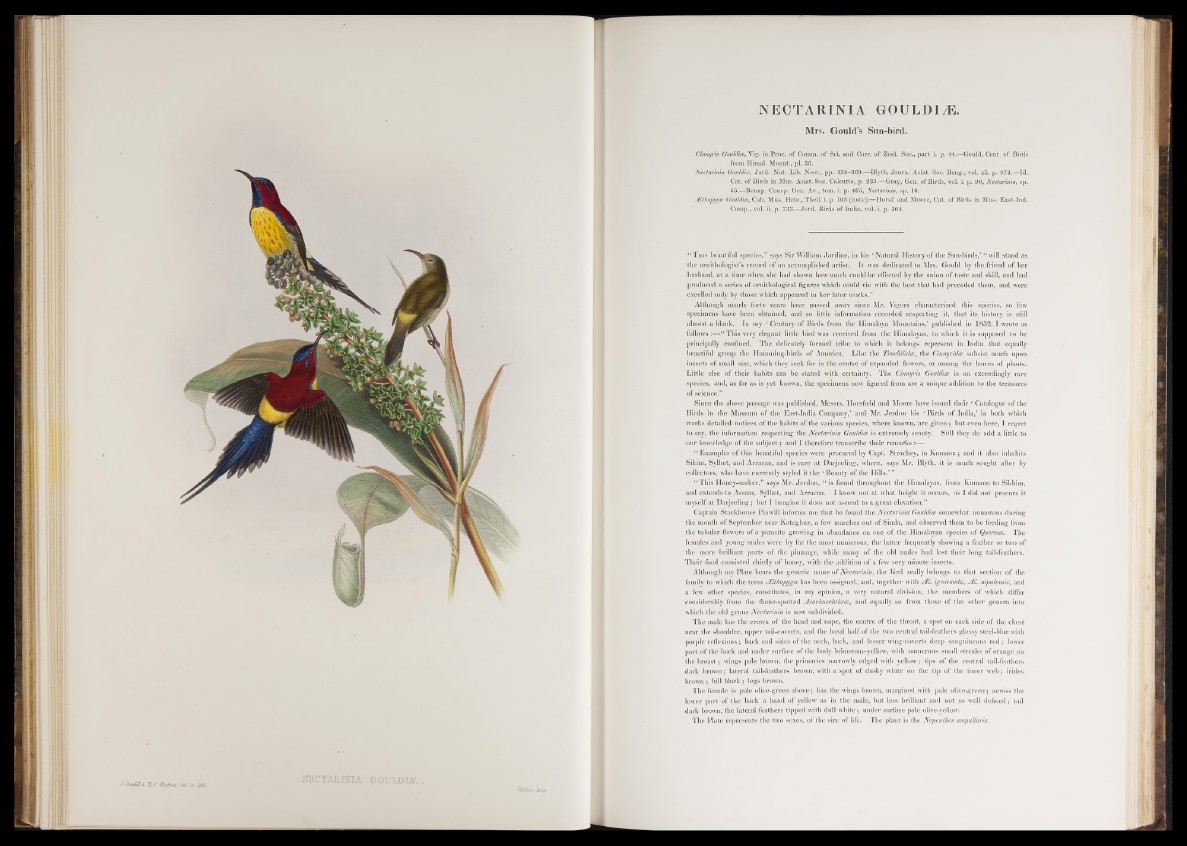
HECTAKIKIA. (
Walter. Imp.
J. GouMj & S. C. Tiuhter, deb co TitJv.
N E C T A R I N I A G O U L D I ^ .
Mrs. Gould’s Sun-bird.
Cinnyris Gouldice, Vig. in Proc. of Comm, of Sci. and Corr. of ZooL Soc., part i. p. 44.—Gould, Cent, of Birds
from Himal. Mount., pi. 56.
Nectarinia Gouldice, Jard. Nat. Lib. Nect., pp. 238-269.—Blyth, Joum. Asiat. Soc. Beng., vol. xii. p. 974.—Id.
Cat. of Birds in Mus. Asiat. Soc. Calcutta, p. 233. —Gray, Gen. of Birds, vol. i. p. 98, Nectarinia, sp.
65.—Bonap. Consp. Gen. Av., tom. i. p. 405, Nectarinia, sp. 10.
JEthopyga Gouldice, Cab. Mus. Hein., Theil. i. p. 103 (note).—Horsf. and Moore, Cat. of Birds in Mus. East-Ind.
Comp., vol. ii. p. 733.—Jerd. Birds of India, vol. i. p. 364.
“ T h is beautiful species,” says Sir William Jardine, in his ‘Natural History o f the Sun-birds,’ “ will stand as
the ornithologist’s record of an accomplished artist. It was dedicated to Mrs. Gould by the friend of her
husband, a t a time when she had shown how much could be effected by the union of taste and skill, and had
produced a series of ornithological figures which could vie with the best that had preceded them, and were
excelled only by those which appeared in her later works.”
Although nearly forty years have passed away since Mr. Vigors characterized this species, so few
specimens have been obtained, and so little information recorded respecting it, that its history is still
almost a blank. In my ‘ Century of Birds from the Himalaya Mountains,’ published in 1 8 3 2 ,1 wrote as
follows This very elegant little bird was received from the Himalayas, to which it is supposed to be
principally confined. The delicately formed tribe to which it belongs represent in India that equally
beautiful group the Humming-birds of America. Like the Trochilidce, the Cinnyridce subsist much upon
insects of small size, which they seek for in the centre of expanded flowers, or among the leaves of plants.
Little else o f tbeir habits can be stated with certainty. The Cinnyris Gouldice is an exceedingly rare
species, and, as far as is yet known, the specimens now figured from are a unique addition to the treasures
of science.”
Since the above passage was published, Messrs. Horsfield and Moore have issued their ‘ Catalogue of the
Birds in the Museum of the East-India Company,’ and Mr. Jerdon his ‘ B irds of India,’ in both which
works detailed notices of the habits of the various species, where known, are given ; but even here, I regret
to say, the information respecting the Nectarinia Gouldice is extremely scanty. Still they do add a little to
our knowledge of the subject; and I therefore transcribe their remarks :—
“ Examples of this beautiful species were procured by Capt. Strachey, in Kumaon; and it also inhabits
Sikim, Sylhet, and Arracan, and is rare at Darjeeling, where, says Mr. Blyth, it is much sought after by
collectors, who have currently styled it the ‘ Beauty of the Hills.’ ’’
“ This Honey-sucker,” says Mr. Jerdon, “ is found throughout the Himalayas, from Kumaon to Sikhim,
and extends to Assam, Sylhet, and Arracan. I know not at what height it occurs, as I did not procure it
myself at Darjeeling; but I imagine it does not ascend to a great elevation.”
Captain Stackhouse Pinwill informs me that he found the Nectarinia Gouldice somewhat numerous during
the month of September near Koteghur, a few marches out of Simla, and observed them to be feeding from
the tubular flowers of a parasite growing in abundance on one of the Himalayan species of Quercus. The
females and young males were by far the most numerous, the latter frequently showing a feather or two of
the more brilliant parts of the plumage, while many of the old males had lost their long tail-feathers.
Their food consisted chiefly of honey, with the addition of a few very minute insects.
Although my Plate bears the generic name of Nectarinia, the bird really belongs to that section of the
family to which the term AEthopyga has been assigned, and, together with AE. ignicauda, AE. nipalensis, and
a few other species, constitutes, in my opinion, a very natural division, the members of which differ
considerably from the flame-spotted Arachnechthrce, and equally so from those of the other genera into
which the old genus Nectarinia is now subdivided.
The male has the crown of the head and nape, the centre of the throat, a spot on each side of the chest
near the shoulder, upper tail-coverts, and the basal half o f the two central tail-feathers glossy steel-blue with
purple reflexions; back and sides of the neck, back, and lesser wing-coverts deep sanguineous r e d ; lower
part of the back and under surface of the body brimstone-yellow, with numerous small streaks of orange on
the b rea s t; wings pale brown, the primaries narrowly edged with yellow; tips of the central tail-feathers
dark brown; lateral tail-feathers brown, with a spot of dusky white on the tip of the inner web; irides
brown ; bill black; legs brown.
The female is pale olive-green above; has the wings brown, margined with pale olive-green; across the
lower p art of the back a band o f yellow as in the male, but less brilliant and not so well defined; tail
dark brown, the lateral feathers tipped with dull white; under surface pale olive-yellow.
The Plate represents the two sexes, of the size of life. The plant is the Nepenthes ampullaria.